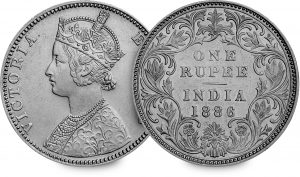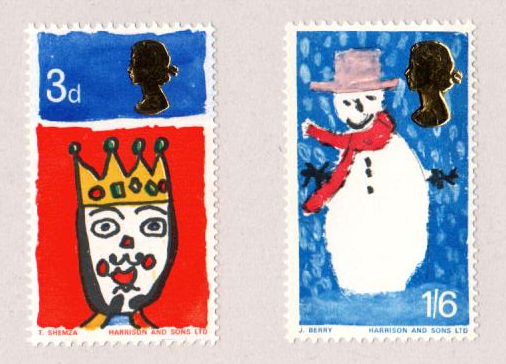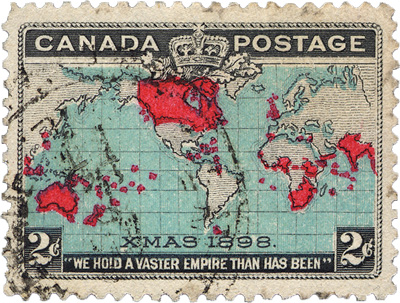Posts Tagged ‘British Empire’
The never-before-seen set of Branch Mint Sovereigns
Branch Mint Sovereigns are a captivating chapter in the world of numismatics, offering an enchanting glimpse into the rich history of gold coinage and the economic influence that spread across the British Empire and beyond. These coins, minted in locations outside the primary mint (the Royal Mint in London), played pivotal roles in the economies of their respective regions.
This blog will take you on a journey through the history, significance, and key dates of Branch Mint Sovereigns, including those from Australia, Canada, South Africa, and India.
>>> Click here to secure your Never-Before-Seen British Empire Sovereign Collection <<<

To distinguish between each of the many Royal Mint locations across the British Empire, gold Sovereigns were for many years marked with a letter symbolising the city or country of their origin. Most gold Sovereign coins were produced in London such as The London Mintmark Sovereign, struck at Tower Hill, and since the 1970s in Llantrisant, South Wales. These coins are unmarked, but many had a small mark above the year of production to indicate their origin.
The concept of Branch Mint Sovereigns emerged in response to the British Empire’s expansive reach and the need for a stable and uniform currency across its vast territories. The Royal Mint, unable to meet the burgeoning global demand for sovereigns, established branch mints in various colonies. These mints not only facilitated local transactions but also promoted economic stability and integration within the Empire.
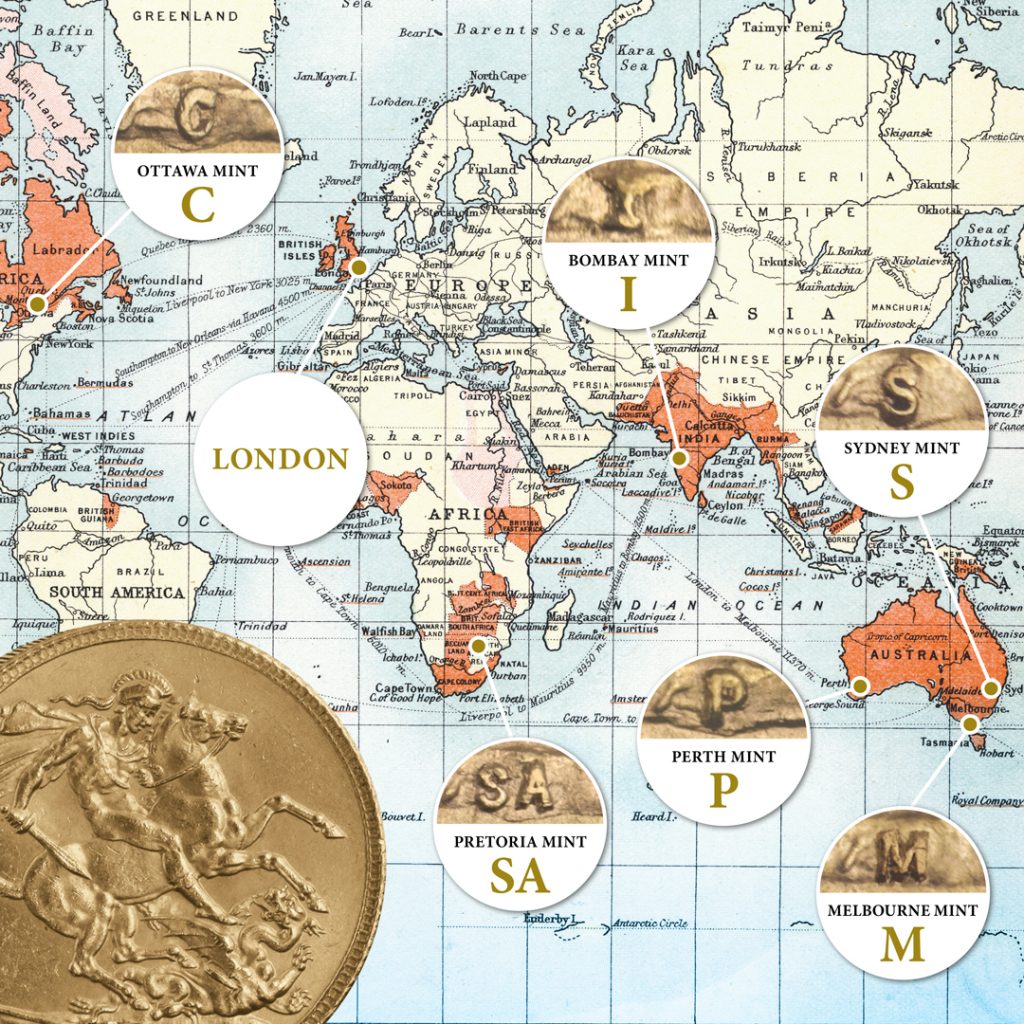
Australian Branch Mints
Australia became a focal point for branch mint sovereigns due to its rich gold deposits discovered during the 19th century. Three main mints operated in Australia:
- Sydney Mint (1855-1926): The first Australian branch mint, it produced sovereigns featuring a unique design with “Sydney Mint” on the reverse until 1870, after which it adopted the standard St. George and the Dragon reverse. These early coins are treasures of history, each telling a story of Australia’s gold rush era. Sovereigns produced in Sydney featured the “S” mintmark.
- Melbourne Mint (1872-1931): Known for its production consistency, the Melbourne Mint produced sovereigns with the “M” mintmark. These coins are prized by collectors for their exquisite craftsmanship and historical significance.
- Perth Mint (1899-1931): The Perth Mint also produced sovereigns marked with a “P”. Its coins stand out for their quality and the rich history of Western Australia’s gold mining legacy.
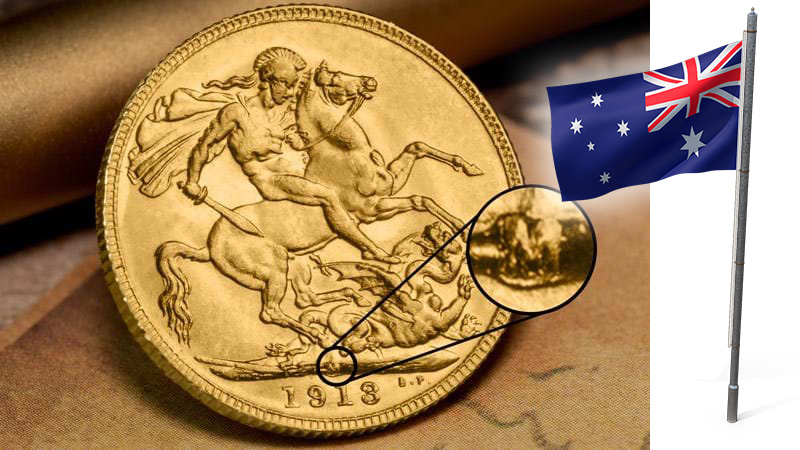
Canadian Branch Mint
The Ottawa Mint, now the Royal Canadian Mint, was established in 1908. Canadian sovereigns, produced between 1908 and 1931, are distinguished by their “O” mintmark. These coins are a testament to Canada’s important role in the British Empire, especially during the First World War. Each sovereign from this era carries with it the story of a nation coming into its own on the global stage.
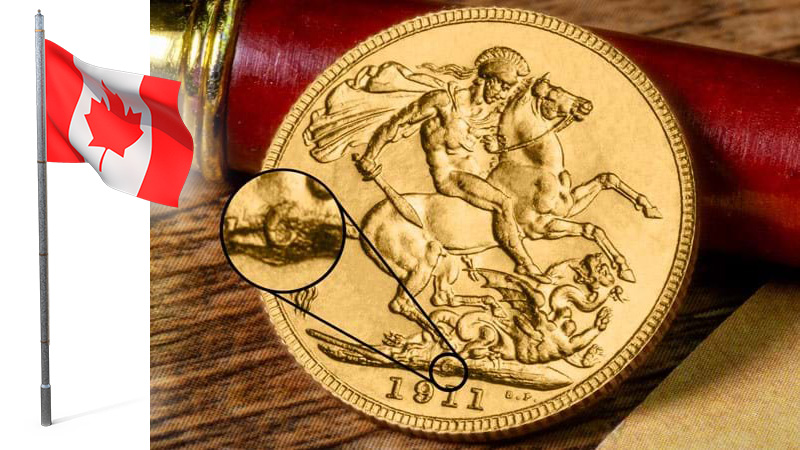
South African Branch Mint
The Pretoria Mint began producing sovereigns in 1923, bearing the “SA” mintmark. These coins are significant due to South Africa’s prominent role in gold production. Sovereigns from the Pretoria Mint circulated widely, symbolizing the region’s economic might and the depth of its natural resources.
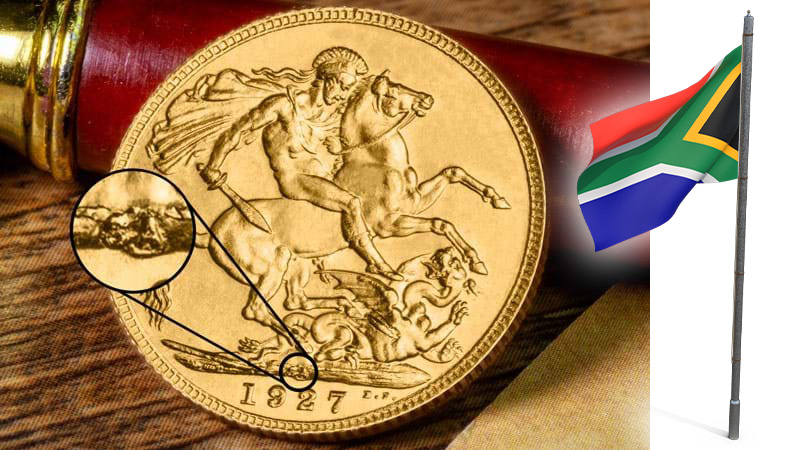
Indian Branch Mint
The Bombay Mint produced sovereigns for a brief period from 1918 to 1919. These coins, marked with an “I” mintmark, are rare and hold a special place in the history of British India. They were minted to address the wartime demand for gold coinage and reflect India’s pivotal role in the British economy. Each coin is a rare gem, representing a fleeting yet crucial moment in history.
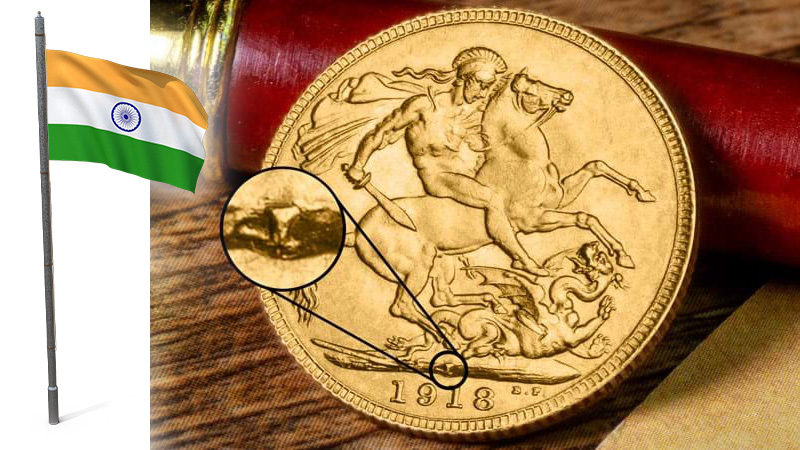
Branch Mint Sovereigns offer a fascinating glimpse into history, connecting the economic dots of the British Empire. From the goldfields of Australia to the financial hubs of Canada, South Africa, and India, these coins represent not just currency but also the economic and cultural exchanges of their time. Collectors and historians alike value these coins for their beauty, rarity, and the stories they tell about an era of global trade and imperial reach.
Dive into the world of Branch Mint Sovereigns with the Complete set of SEVEN ‘Mintmark’ Sovereigns, and let each coin take you on a journey through history. Each Sovereign has been handpicked to complete a set of all seven different mintmarks and all feature the official portrait of George V on the obverse.
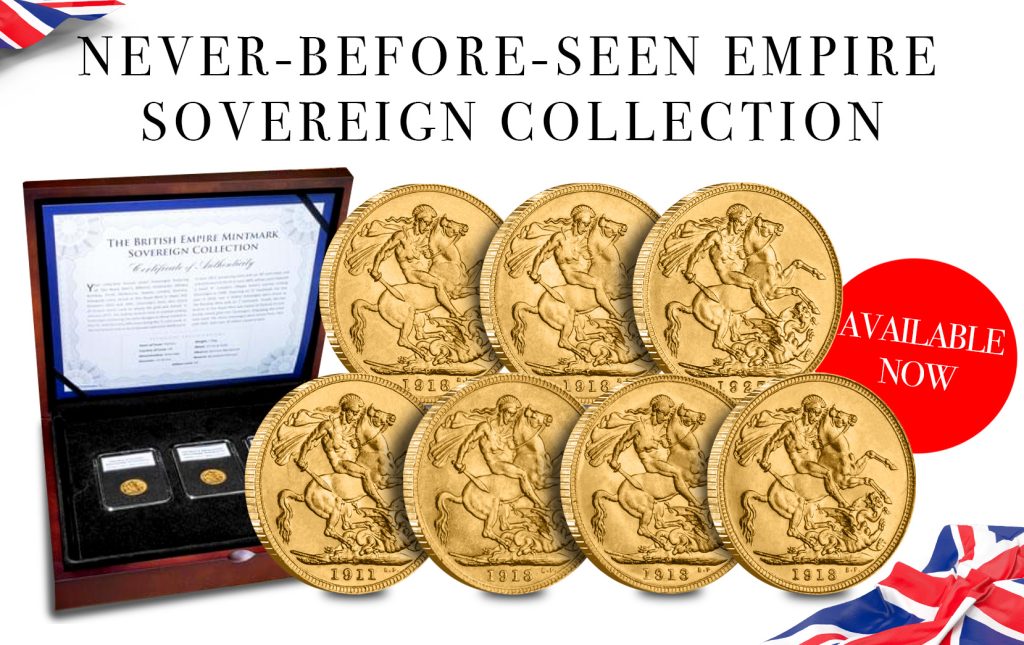
>>> Click here to secure your Never-Before-Seen British Empire Sovereign Collection <<<
How a young queen saw the world without leaving Europe…
Despite ruling over 400 million people in an empire that covered almost a quarter of the world’s surface, Queen Victoria had never set foot in many of the countries that she ruled over.
For many of those people, the only way to catch a glimpse of their empress was by looking at the portraits on the coins that passed through their hands every day. These coins formed a vital connection between people, even though they may have lived on opposite sides of the world and experienced very different lives.
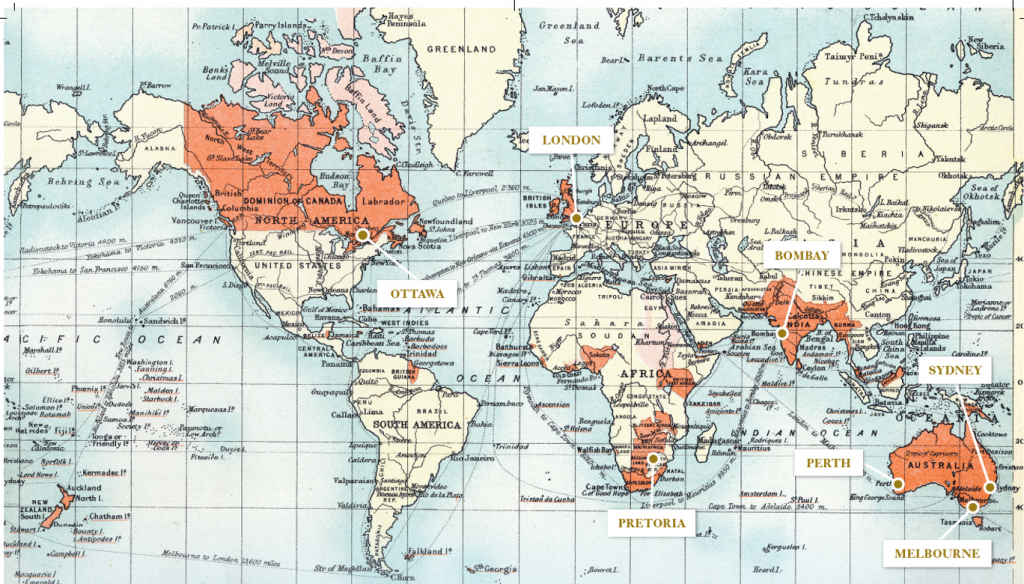
India became known as the Jewel in the Empire’s crown, and was so important to Victoria that she was awarded the title of the “Empress of India” in 1876. Although she never stepped foot in the subcontinent, the currency of India (the rupee) was minted with her portrait on from 1840, so people could recognise their empress despite living 4,500 miles away!
The rupee is one of the oldest currencies in the world, so to feature a British monarch for the first time was an important moment in numismatic history. The later portrait issued on rupees was similar to the Gothic Head effigy can be considered one of the most beautiful coins of the empire.
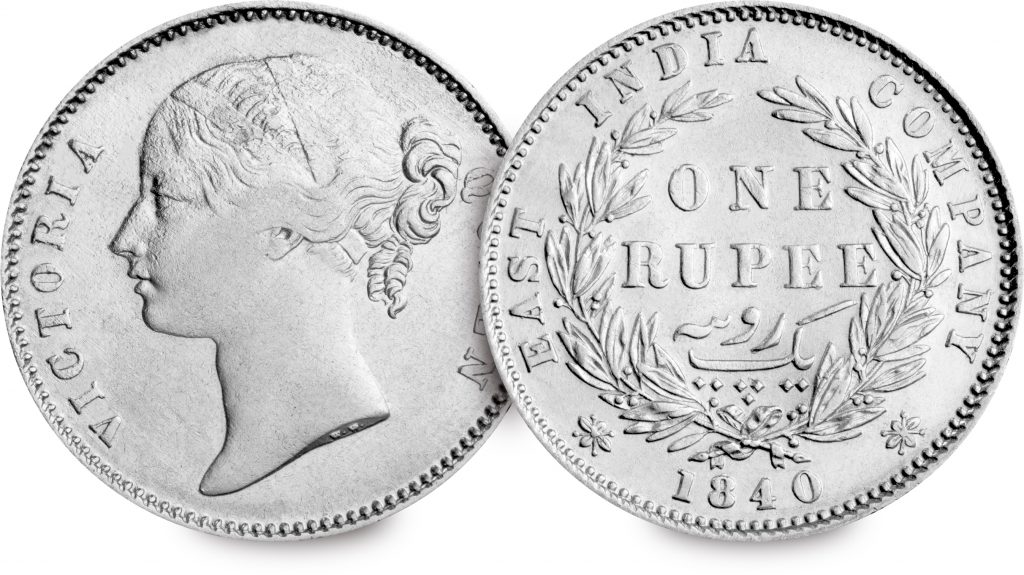
1840 Indian Rupee 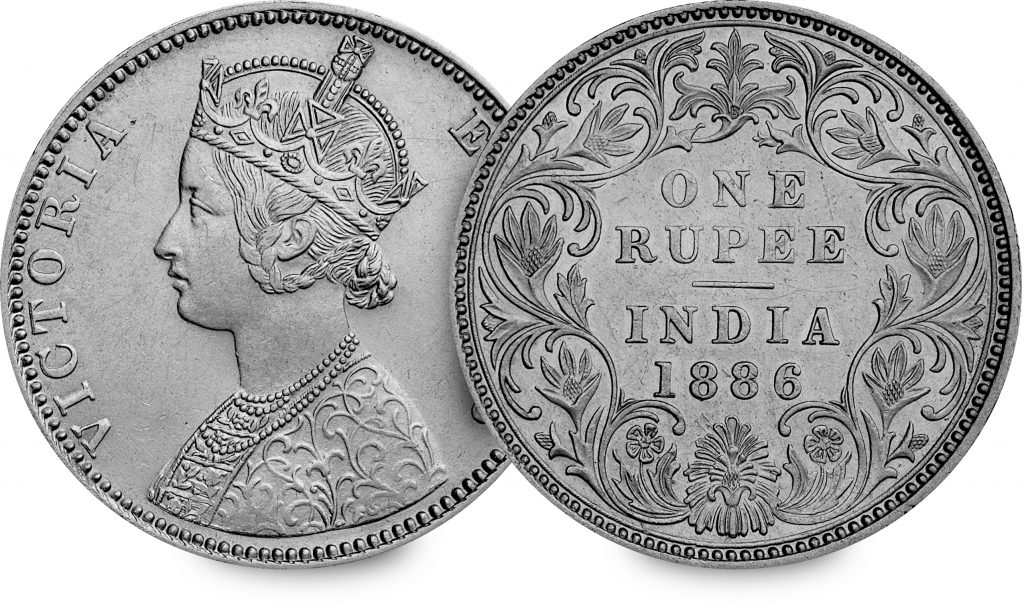
1886 Indian Rupee
Another numismatic first took place in Australia in 1855, one more country that Victoria never visited (which is hardly surprising as it would have taken her almost two months to get there!). As the empire grew, so did the need for coins and the Royal Mint opened branches in Australia to mint sovereigns for the empire. In 1855 the first ever sovereign to be minted outside of the UK, the Sydney sovereign, was issued. It featured a portrait of Victoria that was based on the Young Head effigy, but with a sprig of banksia weaved through Victoria’s hair, giving the portrait a distinct Australian feel.
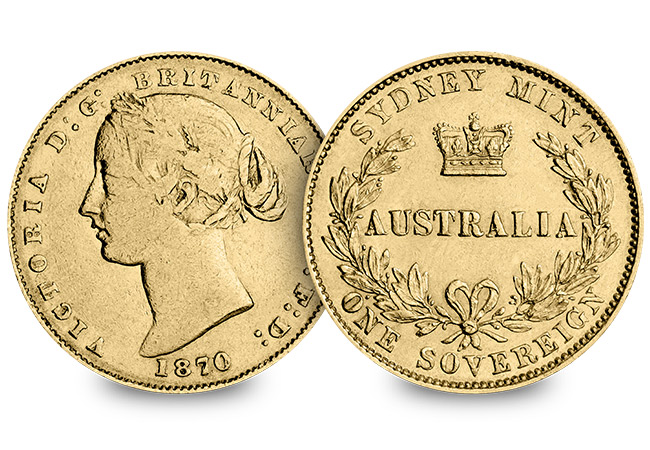
A number of Royal Mint branches were opened throughout Australia after the success of the Sydney sovereign. To identify the mint that sovereigns were produced in, mintmarks were added to the coins, with a small ‘P’ for Perth, and an ‘M’ for Melbourne. The sovereign became legal tender in the majority of British colonies in the 1860s, and its importance in British trade, and worldwide circulation earned it the title “the King of Coins”. By the final years of the British Empire, the sovereign was minted in four continents across the globe.
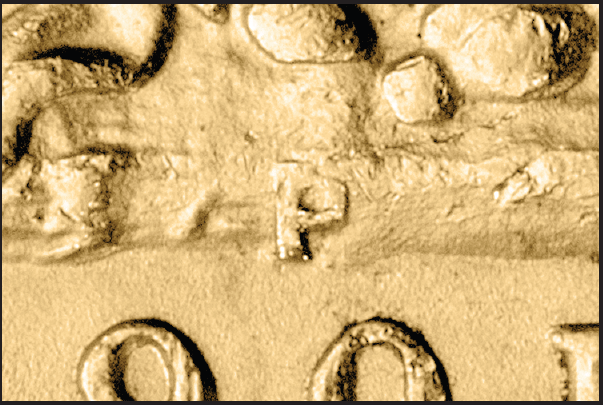
‘P’ Mintmark for sovereigns minted in Perth 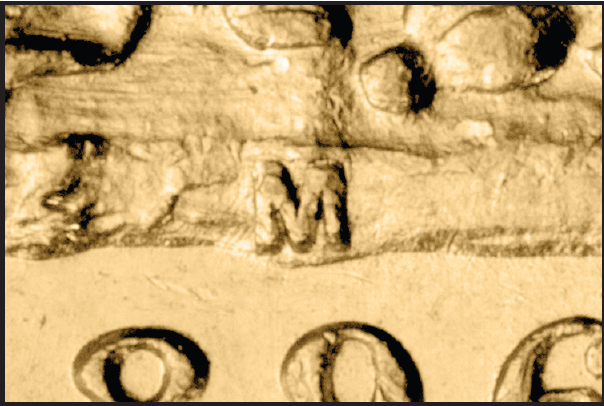
‘M’ Mintmark for sovereigns minted in Melbourne
India and Australia weren’t the only countries that saw Victoria’s portrait. Her image also reached as far as Hong Kong, Ceylon, East Africa and New Zealand. In 1870 the first Canadian dollar with Victoria’s portrait was issued, taking Victoria’s image to a new side of the world for people to see.
Victoria never left Europe, but her portrait and image stood strong on coins around the world. Whilst she never stepped foot in many of the countries that she ruled over, that didn’t stop people recognising her image around the world. The coins that they used every day provided a link to the empire that they were a part of, despite the miles between them.
If you’re interested
You can now own a genuine Victorian Silver Rupee, minted over 4,500 miles away! Click here for more info>>>>
Who issued the world’s first Christmas Stamp?
Did you know that since Royal Mail issued their first Christmas stamp in 1966, over 17 billion Christmas stamps have been printed in Britain? But as popular as they are today, Great Britain was late to the table when it came to issuing Christmas stamps. So which country can lay claim to issuing the first Christmas stamp?
The Contenders…
Canada – 1898
The first country to lay claim is Canada, which produced a stamp bearing the words ‘Xmas 1898’. But many people question whether this was really a Christmas stamp at all…
Denmark – 1904
Denmark claims it printed the first Christmas stamp in 1904 after an idea from postmaster, Einar Holboell, to add an extra stamp to the Christmas mail and the money go to help sick children. However these “stamps” were actually labels and not issued for postage.
Austria – 1937
Austria issued two stamps on 12th December 1937 for use on Christmas mail and New Year greeting cards.
Hungary – 1943
Finally, there is Hungary. Many people think the 1943 Hungarian stamps to be the first real Christmas stamps as they feature religious imagery.
The secret behind the Canadian stamp
It is fair to say however that the issue of the Canadian Christmas stamp did not really have much to do with Christmas. In fact it was a result of then Canadian Postmaster General William Mulock lobbying to standardise postage rates across the Empire at one penny.
After failing to get the new rules introduced at the 1897 Universal Postal Union, Mulock returned the following year more determined than ever, with a new proposal. This time he succeeded, and in July 1898, the Imperial Penny Postage rate was unveiled. Canada made the move to be effective on Christmas day 1898.
As a result, the stamp was officially released on 7th December 1898 bearing Mercator’s famous map with the British Empire highlighted in red, and also the words “XMAS 1898”.
So who can lay claim to issuing the first Christmas stamp?
Well despite the controversy, to me, there is only one winner – and that is Canada. Whether it was issued specifically for Christmas or not, it bears the words ‘Xmas 1898‘ and therefore I think it rightly deserves the title of first Christmas stamp.

